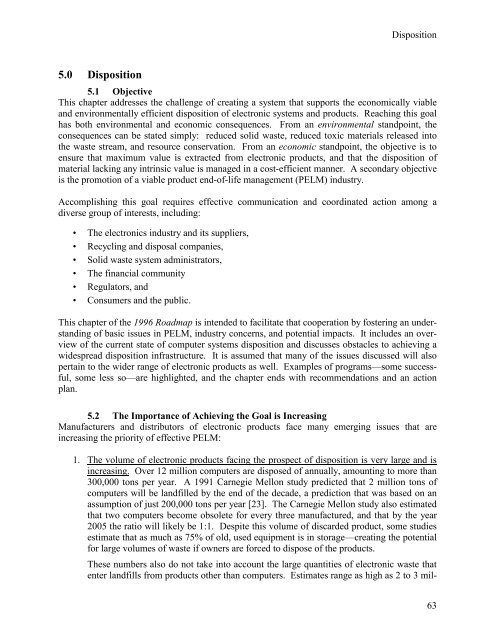1996 Electronics Industry Environmental Roadmap - Civil and ...
1996 Electronics Industry Environmental Roadmap - Civil and ...
1996 Electronics Industry Environmental Roadmap - Civil and ...
Create successful ePaper yourself
Turn your PDF publications into a flip-book with our unique Google optimized e-Paper software.
5.0 Disposition<br />
Disposition<br />
5.1 Objective<br />
This chapter addresses the challenge of creating a system that supports the economically viable<br />
<strong>and</strong> environmentally efficient disposition of electronic systems <strong>and</strong> products. Reaching this goal<br />
has both environmental <strong>and</strong> economic consequences. From an environmental st<strong>and</strong>point, the<br />
consequences can be stated simply: reduced solid waste, reduced toxic materials released into<br />
the waste stream, <strong>and</strong> resource conservation. From an economic st<strong>and</strong>point, the objective is to<br />
ensure that maximum value is extracted from electronic products, <strong>and</strong> that the disposition of<br />
material lacking any intrinsic value is managed in a cost-efficient manner. A secondary objective<br />
is the promotion of a viable product end-of-life management (PELM) industry.<br />
Accomplishing this goal requires effective communication <strong>and</strong> coordinated action among a<br />
diverse group of interests, including:<br />
The electronics industry <strong>and</strong> its suppliers,<br />
Recycling <strong>and</strong> disposal companies,<br />
Solid waste system administrators,<br />
The financial community<br />
Regulators, <strong>and</strong><br />
Consumers <strong>and</strong> the public.<br />
This chapter of the <strong>1996</strong> <strong>Roadmap</strong> is intended to facilitate that cooperation by fostering an underst<strong>and</strong>ing<br />
of basic issues in PELM, industry concerns, <strong>and</strong> potential impacts. It includes an overview<br />
of the current state of computer systems disposition <strong>and</strong> discusses obstacles to achieving a<br />
widespread disposition infrastructure. It is assumed that many of the issues discussed will also<br />
pertain to the wider range of electronic products as well. Examples of programs—some successful,<br />
some less so—are highlighted, <strong>and</strong> the chapter ends with recommendations <strong>and</strong> an action<br />
plan.<br />
5.2 The Importance of Achieving the Goal is Increasing<br />
Manufacturers <strong>and</strong> distributors of electronic products face many emerging issues that are<br />
increasing the priority of effective PELM:<br />
1. The volume of electronic products facing the prospect of disposition is very large <strong>and</strong> is<br />
increasing. Over 12 million computers are disposed of annually, amounting to more than<br />
300,000 tons per year. A 1991 Carnegie Mellon study predicted that 2 million tons of<br />
computers will be l<strong>and</strong>filled by the end of the decade, a prediction that was based on an<br />
assumption of just 200,000 tons per year [23]. The Carnegie Mellon study also estimated<br />
that two computers become obsolete for every three manufactured, <strong>and</strong> that by the year<br />
2005 the ratio will likely be 1:1. Despite this volume of discarded product, some studies<br />
estimate that as much as 75% of old, used equipment is in storage—creating the potential<br />
for large volumes of waste if owners are forced to dispose of the products.<br />
These numbers also do not take into account the large quantities of electronic waste that<br />
enter l<strong>and</strong>fills from products other than computers. Estimates range as high as 2 to 3 mil-<br />
63






